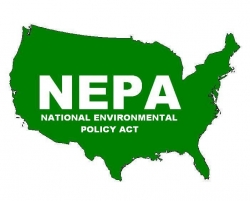 The National Environmental Policy Act (NEPA), which was signed into law on January 1, 1970, was enacted to “declare a national policy which will encourage productive and enjoyable harmony between man and his environment.” Unfortunately,the National Environmental Policy Act has not only become a roadblock to getting critical work done on the ground, but is taking years longer than ever intended and costing way more than is necessary. That is why the Forest Service is currently seeking to modernize their NEPA regulations for the first time in a quarter century; which, with over 100 million acres of FS lands at some risk of catastrophic wildfire, the modernization can’t come quick enough.
The National Environmental Policy Act (NEPA), which was signed into law on January 1, 1970, was enacted to “declare a national policy which will encourage productive and enjoyable harmony between man and his environment.” Unfortunately,the National Environmental Policy Act has not only become a roadblock to getting critical work done on the ground, but is taking years longer than ever intended and costing way more than is necessary. That is why the Forest Service is currently seeking to modernize their NEPA regulations for the first time in a quarter century; which, with over 100 million acres of FS lands at some risk of catastrophic wildfire, the modernization can’t come quick enough.
Simply put,the National Environmental Policy Act needs to be more responsive to the needs of our forests and communities. Guidance from the Council on Environmental Quality recommends that Environmental Impact Statements (EIS’s) should only be used for projects that will have significant environmental impacts, and they should be completed in 1 year or less, and should generally be less than 300 pages. But, a report by the Government Accountability Office has showcased that it now takes the FS an average of 1,300 days and over 1,000 pages to complete an EIS. So instead of getting work done on the ground, FS employees spend significant amounts of time and funding writing documents. This does not benefit the resource, or the communities that surround National Forest land.
In order to reduce the “analysis paralysis” that has plagued the Forest Service NEPA process, things needs to change. For instance, the Forest Service should have streamlined procedures for any projects that have been identified for timber harvesting. They should also develop a restoration Categorical Exclusion (CE) as recommended by the Western Governor’s Association recent report on Forest and Rangeland Management. Also, No-Action alternatives should fully address the environmental effects of NOT doing work. Finally, the FS should declare an emergency on all Federal lands designated as condition class 2 or 3 on wildfire risk maps, as well as lands identified as priorities for treatment in Community Wildfire Protection Plans, and adopt streamlined NEPA compliance strategies for all such lands.
I encourage all of you who are frustrated with the lack of work getting done on federal lands to submit comments to the FS by February 2nd using the following link: https://cara.ecosystem-management.org/Public/CommentInput?project=ORMS-1797
Molly Pitts
Rocky Mountain States Director
Healthy Forests, Healthy Communities